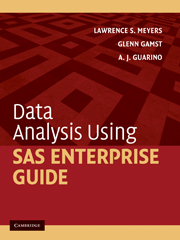Book contents
- Frontmatter
- Contents
- Preface
- Acknowledgments
- I Introducing SAS Enterprise Guide
- II Performing Analyses and Viewing Output
- III Manipulating Data
- IV Describing Data
- V Score Distribution Assumptions
- VI Correlation and Prediction
- VII Comparing Means: The t Test
- VIII Comparing Means: ANOVA
- IX Nonparametric Procedures
- X Advanced ANOVA Techniques
- 30 One-Way Between-Subjects Analysis of Covariance
- 31 One-Way Between-Subjects Multivariate Analysis of Variance
- XI Analysis of Structure
- References
- Author Index
- Subject Index
31 - One-Way Between-Subjects Multivariate Analysis of Variance
Published online by Cambridge University Press: 05 June 2012
- Frontmatter
- Contents
- Preface
- Acknowledgments
- I Introducing SAS Enterprise Guide
- II Performing Analyses and Viewing Output
- III Manipulating Data
- IV Describing Data
- V Score Distribution Assumptions
- VI Correlation and Prediction
- VII Comparing Means: The t Test
- VIII Comparing Means: ANOVA
- IX Nonparametric Procedures
- X Advanced ANOVA Techniques
- 30 One-Way Between-Subjects Analysis of Covariance
- 31 One-Way Between-Subjects Multivariate Analysis of Variance
- XI Analysis of Structure
- References
- Author Index
- Subject Index
Summary
Overview
The ANOVA designs discussed in Chapters 23 through 26 examined the effect of one or more independent variables on a single dependent variable. Because such designs focus on a single dependent variable, they are labeled as univariate ANOVA designs. The present chapter addresses designs in which two or more dependent variables are analyzed simultaneously; such designs are known as multivariate analysis of variance (MANOVA) designs. We limit our discussion to the simplest illustration of such a design: a two-group one-way between-subjects design. More information about MANOVA can be found in Meyers et al. (2006), Stevens (2002), and Warner (2008).
Univariate and multivariate ANOVA
Univariate ANOVA designs are extremely useful but their focus is on a single outcome measure. For example, in evaluating a new curriculum designed to teach children to read more quickly, a natural variable to measure is reading speed. But at the same time that the reading speed of the children was improving (assuming a successful curriculum), there might potentially be other variables changing in synchrony, such as reading comprehension, enhanced levels of self-confidence, and feelings of mastery. Perhaps improvements in other academic subjects might be observed as well. All of these related (correlated) effects could serve as potential dependent variables. To focus only on one of these variables, reading speed for example, narrows the focus of the study perhaps to an unnecessary extent.
- Type
- Chapter
- Information
- Data Analysis Using SAS Enterprise Guide , pp. 313 - 324Publisher: Cambridge University PressPrint publication year: 2009



